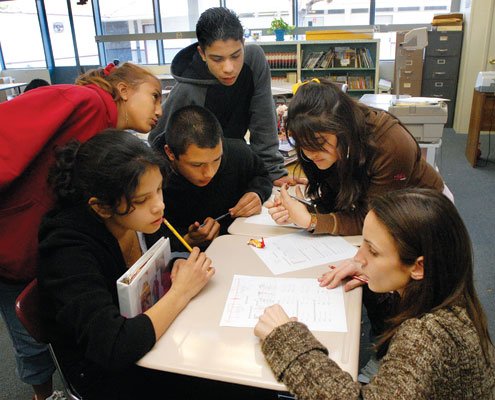Brownell Middle School staff and students are working hard to
boost test scores and bring the English Language Learner subgroup
up to speed with federal educational goals.
Brownell Middle School staff and students are working hard to boost test scores and bring the English Language Learner subgroup up to speed with federal educational goals.
In July, two years into its program improvement (PI) status, Brownell welcomed a new principal with prior experience in working with low scoring ELL students. One of the reasons Francisco Fuentes was hired was to deliver the school from its program improvement status by spring test time.
The tight deadline requires drastic measures on Fuentes’ part.
In addition to their regular English/Language Arts course and a two-hour block of English Development classes during the regular school day, Fuentes is now adding an after-school component to his ELL students’ already rigorous curriculum.
“Academics first,” Fuentes said simply. “Where there’s a will, there’s a way.”
And, by students’ readiness to participate, the will is there, said after-school program teacher, Jennifer Legris who teaches sixth grade language arts and social studies by day.
“Some of them enjoy being here for the extra help, but many don’t really want to sit anymore after a full day,” she said. “It’s tough on them, but they’re here and they work hard.”
ELL students make up 23 percent of Brownell’s population and about 30 of those students attend the after-school sessions on a voluntary basis. Fuentes entered the at-will agreement with his students and their parents and said that both parties have been very cooperative.
“It’s not mandatory for them,” Legris said. “They have to want to be here.”
When the bell rings at the end of the day, middle schoolers pour out into Brownell’s halls, mingling with friends, hopping into their parents’ cars or walking home after a harrowing day of academics and socializing. But as the afternoon sunshine filters in the windows of Legris’ classroom, she circles the clusters of desks filled with students who aren’t off the hook yet. The students stay after school four days a week to receive an extra hour and a half worth of instruction in math and language arts.
Focused on delivering a lesson in rounding numbers, Legris offered encouragement and assistance in a mixture of Spanish and English to her bilingual students.
“That’s perfect,” she said when eighth grader, Jonathan Dominguez, solved a problem correctly on his worksheet. “You did fantastic.”
“It’s nice to see the light bulbs going on above each of their heads,” she said.
Fuentes pulled Dominguez aside to ask him how the program was helping, academically and socially. The principal slung an arm around the student, asking him about his progress. Dwarfed by his towering principal, Dominguez said that, these days, he feels more accepted on campus and is getting better grades as a result of the additional after school help.
“Coming here teaches me more,” he said. “It’s helping really good.”
The smile on Fuentes’ face reflected his genuine interest in the headway his students are making.
The program allows students like Dominguez to brush up on their skills in preparation for the looming bout of testing they will face this spring. If each subgroup, including ELL students, does not make California’s target of 36 percent student proficiency, Brownell will enter its fourth year in program improvement, the consequences of which are severe. Fourth year program improvement could mean significant restructuring or state takeover.
Despite pressure on Brownell, Fuentes, teachers and students remain calm. Confident in his students’ ability to achieve given the right conditions, Fuentes has produced results at his past schools and is optimistic in his ability to do it again, with the dedication of his students and teachers.
“This type of program proved very effective at my previous school,” Fuentes said. After implementing a similar program at his prior school, which had a 40 percent ELL population, they reached their goal. “These kids can do it,” he said. “And they will.”
View more photos of Getting a Boost at our













